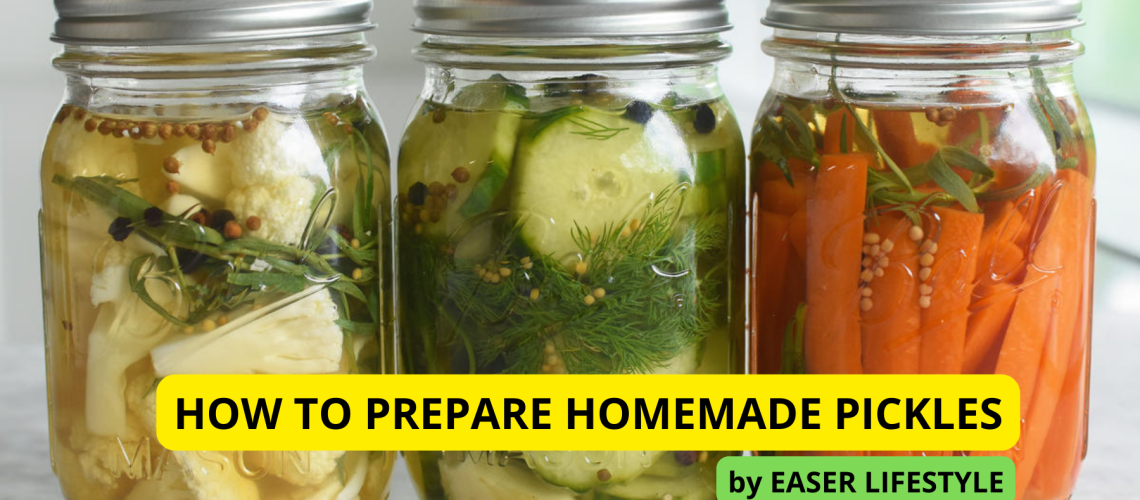Bite into a pickle and you’re instantly connected with a method of food preservation that’s thousands of years old. You too can practice that ancient alchemy by pickling produce in your own kitchen. It’s kind of a big dill.
What Is Pickling?
Put simply, pickling preserves foods by immersion in a vinegar brine or a saltwater brine to suppress microbes that cause food to rot. Depending on the method you use, the process can take a few hours or days for vinegar-brined pickles to be ready to eat, or weeks for saltwater-brined pickles (also called fermented or sour pickles) to reach pickle perfection.
How to Make Homemade Pickles, Step-by-Step

1. Pick Your Produce
Homemade pickles will only be as good as the produce you use. Look for ripe, unblemished fruits and vegetables at their peak of freshness. Pickle pros like to pickle their haul the same day they bring it home.
Wash produce well and trim off stems before pickling, or your batch could turn mushy from the pickling liquid’s interaction with enzymes in the stems.
2. Prep the Brine or Vinegar
The pickle recipe you choose will tell you what kind of liquid to prepare for pickling. For a salted water brine, be sure to use exactly the kind of salt that’s specified. Don’t substitute regular table salt for kosher or sea salt, or your recipe will go into the fail column. Note that sweet pickles will have sugar added to the mix.
3. Add the Aromatics
Whole spices, herbs, garlic, and other ingredients are often added to the pickling liquid to intensify flavors. For example, dill pickles include (you guessed it) dill seed and fresh dill weed in the brine.
To add heat, a spicy dill pickle recipe can add red pepper flakes, too. A sweet dill pickle will go heavier on the sugar. A garlic dill pickle will load up on garlic cloves. Once you get comfortable with pickling, you can start playing around with spices to find what works for you. (See Pickling Spice in the FAQ below.)
4. Put It All Together
The final step is to combine all the elements following recipe directions, and let nature take over.
You can then preserve or “keep” your pickled foods for a few weeks in the fridge, or for the long haul by canning.
Quick Pickles vs. Slow Pickles
Quick: Vinegar-Brined Refrigerator Pickles
This easy, quick-pickling method usually calls for boiling a mixture of vinegar, salt, spices, and sometimes sugar, which is then poured over produce you’ve packed into clean, sealable glass jars. Depending on the recipe, these kinds of pickles can be ready to use right away, the next day, or a week or two later.
Recipes to try:
- Homemade Refrigerator Pickles — These go right into the fridge, but some reviewers canned them.
- Apple Refrigerator Pickles — Includes directions for canning.
- Swedish Pickled Cucumbers — Ready in 3 hours or overnight.
Slow: Saltwater-Brined Fermented Pickles
Vegetables are soaked in a seasoned saltwater brine for a week or more at room temperature, resulting in a natural fermentation process that preserves the vegetables and imparts a sour flavor from Lactobacillus bacteria. When the pickling process is complete, transfer vegetables and brine to a large jar, cover with brine, and store in the refrigerator.
Another kind of fermented pickling calls for the produce to be packed in salt and left to pickle in its own natural juices instead of a salted brine. Kimchi and preserved lemons are produced with this pickling method.
Pickled Proteins
Pickling preserves proteins, too. You can make all kinds of classic and exotic pickled eggs to store in the fridge for tangy snacks.

Recipe shown: Emily’s Pickled Eggs
Pickle FAQ
Q: What are dill pickles?
A: Cucumbers that have been soaked in a brine seasoned with dill seed or leaves or both. Garlic and other whole spices may be included in a dill pickle brine.
Q: What are kosher dill pickles?
A: For these pickles, the term “kosher” refers to pickles produced the way traditional Jewish pickle makers in New York City do it, rather than to Jewish kosher dietary laws. Kosher dill pickles are slowly fermented in a salt brine with dill and garlic.
Q: Is salt brine the only liquid that is used for pickling?
A: No. Vinegar can also be used, especially for pickling fruits.
Q: Where do bread and butter pickles get their name from?
A: These sliced cucumber pickles are made with a sweet and sour vinegar brine. Although the recipe is much older, the story about the origin of the name dates back to the 1920s, when Omar and Cora Fanning trademarked “Fanning’s Bread and Butter Pickles.” As the story goes, these cucumber farmers made it through financial hardship by bartering their pickles for groceries such as bread and butter.
Q: What is pickling spice?
A: A blend of aromatic spices that can include peppercorns, allspice, dill seeds, mustard seeds, coriander, and bay leaves. Added to brine or vinegar, these spices enhance the finished flavor of the pickles. You can purchase jars of pickling spice or make your own pickling spice blend.
Q: What kinds of produce can I pickle?
A: If it grows, you can probably pickle it. An A-to-Z of pickled produce includes:
Article was from allrecipees.com .

